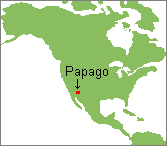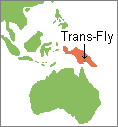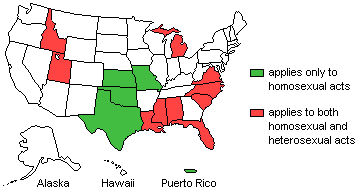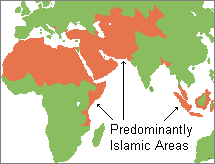Homosexuality
![]() , or the sexual
and/or emotional desire for others of the same gender as oneself, is found widely among
the societies of the world. However, the social acceptance of it varies
dramatically. In fact, the range in permissiveness and restrictiveness with regards
to homosexual acts is at least as great as it is for heterosexual
, or the sexual
and/or emotional desire for others of the same gender as oneself, is found widely among
the societies of the world. However, the social acceptance of it varies
dramatically. In fact, the range in permissiveness and restrictiveness with regards
to homosexual acts is at least as great as it is for heterosexual
![]() ones. In the
United States, for instance, there has been a wide difference in legal restraints on sexuality
from state to state. Some states, like California, essentially have the same
restrictions on both homosexuality and heterosexuality. That is, all sex
acts that do not lead to bodily harm are legal as long as they are done with consenting
adults in private. However, California shares the oldest age of consent (18) among
the states. The youngest (13) is in New Mexico.
ones. In the
United States, for instance, there has been a wide difference in legal restraints on sexuality
from state to state. Some states, like California, essentially have the same
restrictions on both homosexuality and heterosexuality. That is, all sex
acts that do not lead to bodily harm are legal as long as they are done with consenting
adults in private. However, California shares the oldest age of consent (18) among
the states. The youngest (13) is in New Mexico.
Fourteen
states, Puerto Rico, and the U.S. military have criminalized "unnatural sex
acts" or "crimes against nature"--that is, they have anti-sodomy
laws. Sodomy
![]() is generally defined as anal or oral copulation with another person or animal.
It is also sometimes defined in law more ambiguously as non-reproductive sex.
Ten of these states extended
anti-sodomy laws to heterosexual partners as
well. There has been considerable variation in the possible
penalty for this crime. In Louisiana, for instance, sodomy
has been a felony that could result in a 5
year prison sentence, $2000 fine, and exclusion from public jobs
such as teaching and the law. In Idaho, it
theoretically could result in life in prison. However, few people are
prosecuted under anti-sodomy laws in the U.S. In Arkansas, for instance,
the current anti-sodomy law has been in existence since 1977, but there have
not been any prosecutions based on it. In June 2003, the U.S. Supreme
Court struck down a Texas anti-sodomy law. This decision
very likely will have the
effect of nullifying all such laws in the country.
These legal changes regarding homosexuality apparently reflect a growing
acceptance, or at least tolerance, of it among the general public.
is generally defined as anal or oral copulation with another person or animal.
It is also sometimes defined in law more ambiguously as non-reproductive sex.
Ten of these states extended
anti-sodomy laws to heterosexual partners as
well. There has been considerable variation in the possible
penalty for this crime. In Louisiana, for instance, sodomy
has been a felony that could result in a 5
year prison sentence, $2000 fine, and exclusion from public jobs
such as teaching and the law. In Idaho, it
theoretically could result in life in prison. However, few people are
prosecuted under anti-sodomy laws in the U.S. In Arkansas, for instance,
the current anti-sodomy law has been in existence since 1977, but there have
not been any prosecutions based on it. In June 2003, the U.S. Supreme
Court struck down a Texas anti-sodomy law. This decision
very likely will have the
effect of nullifying all such laws in the country.
These legal changes regarding homosexuality apparently reflect a growing
acceptance, or at least tolerance, of it among the general public.
|
U. S.
States With Anti-Sodomy Laws |
|
|
|
|
|
(Data source: SodomyLaws website) |
Elsewhere in the world, attitudes and
legal consequences for homosexuality vary from wide acceptance in Western
Europe to absolute rejection in some nations of the Middle East, Africa, and
Asia. In sixteen nations, the punishment for
sodomy can be life in prison or even death. The most severe penalties are in
the Islamic
![]() nations that adhere to traditional law based on
interpretations of the
Koran
nations that adhere to traditional law based on
interpretations of the
Koran
![]() .
.
|
Severe Penalties
for Homosexuality |
||||
| Life in Prison | Death Penalty |
|
||
|
|
|
|||
|
Uganda Guyana Bangladesh Bhutan India Maldives Nepal Singapore |
Mauritania Nigeria Sudan Afghanistan Pakistan Saudi Arabia United Arab Emirates Yemen |
|||
|
|
|
|||
|
(Data source: SodomyLaws website) |
||||
In considering this information, it is important to keep in mind that the existence of harsh legal consequences for homosexuality does not necessarily result in people being prosecuted. In Afghanistan, for instance, there is a widespread tradition of male homosexuality. Estimates of the number of Afghan men who engage in sex with teenage boys or other men at some time in their lives range from 18-50%. This unusually high frequency is quite surprising since Islamic law in Afghanistan mandates that sodomy be punished by being burned at the stake, pushed off of a cliff, or crushed under a toppled wall. In 1998, three homosexual men were executed in the city of Kandahar by the then ruling ultraconservative Taliban by having a tank push a brick wall over on them.
There is a curious double standard in regards to anti-homosexual laws--they do not always apply to lesbians. This may be due to the fact that the existence of female homosexuality is less likely to be socially acknowledged or that it is considered acceptable behavior, at least in private. This double standard is most common in the South Pacific Islands, the non-Islamic nations of Africa, and some Caribbean Islands on which a high percentage of the population has Sub-Saharan African ancestral roots. Governments may even officially deny that any form of homosexuality occurs. This apparently has been the the case in Albania, Bangladesh, Congo, Lebanon, and Liberia.
|
Nations in Which Only Male Homosexuality is
Criminalized |
||||||||||
|
South Pacific |
Africa | Caribbean | Central Asia | Southeast Europe | Indian Ocean | |||||
|---|---|---|---|---|---|---|---|---|---|---|
|
|
|
|
|
|
|
|||||
| Cook
Islands Fiji Kiribati Marshall Islands Niue Papua New Guinea Solomon Islands Tokelau Tonga Tuvalu |
Botswana Ghana Mozambique Namibia Nigeria Tanzania Uganda Zambia Zimbabwe |
Grenada Guyana Jamaica |
Kyrgyzstan Tajikistan Turkmenistan Uzbekistan |
Armenia Srbska |
Maldives Sri Lanka |
|||||
|
|
||||||||||
|
(Data source: SodomyLaws website) |
||||||||||
In 1991, the World Health Organization removed homosexuality as an illness from their classification of diseases. Contrary to common belief in Western Nations, laws criminalizing homosexuality are not universally disappearing around the world. In the 1990's, Nicaragua enacted a law making it a crime. However, in the same decade, 8 nations and territories rescinded their anti-homosexuality statutes (Bahamas, Belize, Chile, Hong Kong [China], Ireland, Latvia, Russia, and Ukraine).
 |
In
some societies, homosexuality has been socially accepted but limited to certain times and
to certain individuals. For example, The Papago
![]() Indians of southern Arizona
traditionally set aside nights during which any man could perform homosexual acts.
Women could as well if they had the permission of their husbands.
Indians of southern Arizona
traditionally set aside nights during which any man could perform homosexual acts.
Women could as well if they had the permission of their husbands.
The Papago also had a
socially accepted status for transvestite
![]() men. They wore women's clothing
throughout the year and did women's chores. Unmarried men were allowed to visit
them for homosexual acts.
men. They wore women's clothing
throughout the year and did women's chores. Unmarried men were allowed to visit
them for homosexual acts.
NOTE: transvestitism, or the wearing of clothes and bodily adornment normally associated with the other gender, is not necessarily connected with homosexuality. It is important to understand the specific cultural patterns. In North America, for instance, some strictly heterosexual men are sexually stimulated by putting on female clothes, especially undergarments. Likewise, many homosexual men do not wear such garb or even approve of it.
 |
|
North
American woman wearing |
|
 |
|
|
Heterosexual Plains Indian man |
|
There is a double standard in regards to transvestitism, or cross dressing, in North America today. Women are permitted to wear overtly masculine clothing without social disapproval, especially in business and recreational settings. However, American men are much more restricted in their clothing choices. When it becomes known that a man wears dresses or other female garb, he is almost universally stigmatized and often labeled as a homosexual. This can have major negative effects on his career, social life, and even personal safety.
 |
|
The anthropologically most well known transvestites who also
often happened to be homosexuals were the berdache
![]() , or two-spirited, men of
the North American Great Plains Indian tribes. These men led the lives of women and
had socially accepted statuses--they were valued members of their societies.
, or two-spirited, men of
the North American Great Plains Indian tribes. These men led the lives of women and
had socially accepted statuses--they were valued members of their societies.
Heterosexual Plains Indian men who were going on hunting or war expeditions generally held the view that sex with their wives or other women was polluting and depleting. In contrast, a two-spirited man did not pose these dangers. As a result, two-spirited men were regularly taken along to perform women's chores and to entertain. Some of them were renowned story tellers.
The Hijras
![]() of India
are another example of a culturally accepted (or at least tolerated) male transvestite
status. These are men who dress as women but apparently are not often homosexual. Many Hijras even have their genital organs surgically removed to
symbolize their transition to "womanhood." They are devotees of the Hindu
mother goddess Bahuchara Mata. Through emasculation, they express their faith in
her and become conduits for her power. The Hijras are difficult to label as to
gender. They identify themselves as "incomplete men", "incomplete
women", or "inbetweens", but the Indian national census counts them as
women. There are about 50,000 true Hijras today living mostly in North Indian urban
centers. They work at many different kinds of jobs
including construction. However, the largest percentage of them make
their living by blessing babies and entertaining at parties. Some of the
better Hijra musicians, dancers, and singers perform regularly in Indian films. Recently, a
few of the Hijras have successfully run for public office, especially in Utar
Pradesh State. In 2003, however, a court in Madhya Pradesh State ruled
that a Hijra must give up his office as mayor of Katni because he is a male
and this political office was reserved for women. There are 10's of thousands of other eunuchs and
homosexuals in India who dress as women and falsely claim to be Hijras. Many of
them make their living on the edges of society by prostitution or by extorting
money for blessing children. Few people refuse to give them money for
fear of being cursed.
of India
are another example of a culturally accepted (or at least tolerated) male transvestite
status. These are men who dress as women but apparently are not often homosexual. Many Hijras even have their genital organs surgically removed to
symbolize their transition to "womanhood." They are devotees of the Hindu
mother goddess Bahuchara Mata. Through emasculation, they express their faith in
her and become conduits for her power. The Hijras are difficult to label as to
gender. They identify themselves as "incomplete men", "incomplete
women", or "inbetweens", but the Indian national census counts them as
women. There are about 50,000 true Hijras today living mostly in North Indian urban
centers. They work at many different kinds of jobs
including construction. However, the largest percentage of them make
their living by blessing babies and entertaining at parties. Some of the
better Hijra musicians, dancers, and singers perform regularly in Indian films. Recently, a
few of the Hijras have successfully run for public office, especially in Utar
Pradesh State. In 2003, however, a court in Madhya Pradesh State ruled
that a Hijra must give up his office as mayor of Katni because he is a male
and this political office was reserved for women. There are 10's of thousands of other eunuchs and
homosexuals in India who dress as women and falsely claim to be Hijras. Many of
them make their living on the edges of society by prostitution or by extorting
money for blessing children. Few people refuse to give them money for
fear of being cursed.
 |
 |
Do you think that the people in these photos are real women or Hijras? |
The Etoro
![]() and some other societies of
the Trans-Fly River region in southern New Guinea provide an extreme example of the social
acceptance of male homosexuality. Apparently, all Etoro men engage in homosexual
acts and most also marry and engage in heterosexual acts with their wives. However,
heterosexual intercourse is prohibited for up to 260 days of the year and is forbidden in
or near their houses and vegetable gardens. In contrast, homosexual relations are
permitted at any time.
and some other societies of
the Trans-Fly River region in southern New Guinea provide an extreme example of the social
acceptance of male homosexuality. Apparently, all Etoro men engage in homosexual
acts and most also marry and engage in heterosexual acts with their wives. However,
heterosexual intercourse is prohibited for up to 260 days of the year and is forbidden in
or near their houses and vegetable gardens. In contrast, homosexual relations are
permitted at any time.
 |
 |
|
| Jiwiki men in New Guinea |
The Etoro believe that homosexual acts make crops flourish and boys strong. Etoro men and women mostly live apart so that social contact between them is generally limited and often hostile. Not surprisingly, their birth rates are low. To compensate for this problem and to avoid depopulation, they allegedly have stolen children from neighboring societies and raised them as their own.
There is no clear explanation as to why societies are permissive or restrictive in regards to homosexuality. However, there are two interesting correlations. First, societies that strongly forbid abortion and infanticide are likely to be equally intolerant of homosexuality. Second, societies that have frequent severe food shortages are more likely to allow homosexuality. An implication is that homosexuality may be tolerated and even encouraged when there is severe population pressure. Heterosexual abstinence and other birth control methods would be expected to be common then also. That appears to have been the case with the Plains Indians and some New Guinea societies.
NOTE: It is not clear what leads one person to be homosexual and another to be heterosexual or bisexual. Both environmental and social factors have been proposed by psychologists and others engaged in researching this question. In reality, both kinds of factors may be involved to some degree. In addition, an individual may change sexual preference at different phases of his or her life. Anthony Bogaert's recent research at Brock University in St. Catharines, Ontario, Canada indicates that birth order within a family may be an important factor in male homosexuality. He found that the more biological older brothers a man has, the more likely he will be homosexual, and that it does not matter if he is raised with his older brothers. It may be that each succeeding pregnancy with a male child somehow causes a mother's immune system to respond to male fetuses in a way that changes their sex-related brain development. This same correlation between male birth order and homosexuality does not occur if older siblings are half-brothers, stepbrothers, or adopted brothers. (Science News Vol. 170 July 1, 2006)

